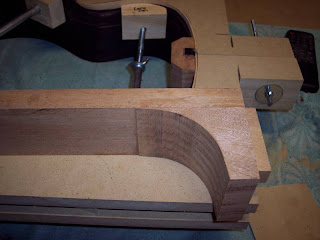I spent some time working on the rosette of the SJ. I had three pieces of rosette blank wood that I purchased from Bob at RC Tonewoods to choose from. I had Red Myrtle, Olivewood, and Box Elder. After some thought, I decided to use the Box Elder. I like the lighter colored wood, but really like the pink splash on one side. With this being the first rosette I have cut myself, I had to figure out just exactly how to do this. After a bit of head scratching I worked it through in my mind and then went about cutting it out. The hardest part to figure out was first, the exact dimensions I wanted, but then how to hold the little piece of wood down and cut the circles without any of the parts moving. I settled on a very simple but effective method. (Isn't that the way it always works out, the simplest things usually are the most effective!) Anyways, I drilled and set the center post for my circle cutter, then I countersunk a screw next to the pivot point to hold the wood securely down . After thinking about how to go about cutting it, I realized that if I cut the inner circle first, there would be no way to hold the outer blank securely and more importantly dead center on the pivot because my point of attachment would now be free. So, I cut the outer ring first. This kept the circle still screwed to the table and the center point was still the reference point of the cut. I then cut the outer ring all the way to within a hair of all the way around. I was concerned that if I cut all the way around, the outer ring could move before I got the router out and then it would damage the edge of the rosette. It worked well. I had some sanding of the edges to do because it wasn't perfectly smooth, but it turned out very nicely.
I then routed the channel in the top. This was fairly simple. I started my cut within the body of the rosette and then moved slowly inwards and outwards until I had the channel exactly the size I needed. I then needed to decide on trim colors. I purchased several different pieces of colored trim strips - red, green, maple, black, and bloodwood. I decided against bloodwood and maple right off the bat because the bloodwood is so brittle and it is almost the same color as the red I had which is much more flexible, and the maple is so light that it would not show up. I set the rosette and red, then green, then black trim up as well as the abalone that will surround it to see what I liked. I settled on black. I liked the red, but since the headstock, fingerboard, and bridge are all ebony, I thought that the black tied it with that color scheme. I cut the pieces, and glued the rosette and trim to the top. Tomorrow I will try and get it sanded flat and then route out the next channel for the abalone and final trim piece. I think it will look really nice.
Finally, (sorry I know this has been long!) when I left the shop I had a little visitor in my front yard. A baby fox was in my yard looking for something to eat. We have two outdoor barn cats that are constantly catching mice but they rarely eat them. We are always finding little 'gifts' in the grass or on the sidewalk left by our cats. (YUCK!) Anyways this little fox was running around the yard sniffing for food and found one of the gifts for dinner. He hung around for about 5 minutes before a truck came up the road and scared it away. He wasn't afraid of me at all and he kept looking at me and then sniffing around. It was kind of fun. These guys are so cute that you want to play with them, but then I remember that they are wild and who knows what kind of diseases they carry. So, I keep my distance!

Here is the box elder blank. You will notice that I didn't center the pin on the wood. I wanted to get as much of the pink as I could in the rosette, but there is a knot in the top right corner, and there was a fairly big crack on the bottom right corner. I needed the outer cut to just skirt those flaws.

Then the inner cut. If you look at the top of the cut, you can see the tiny piece I left uncut to hold the ring from moving.

Sample number 1. Red trim. I really liked this but decided against it because of the black elsewhere on the guitar. I just didn't think it fit the theme I was going for.
























































